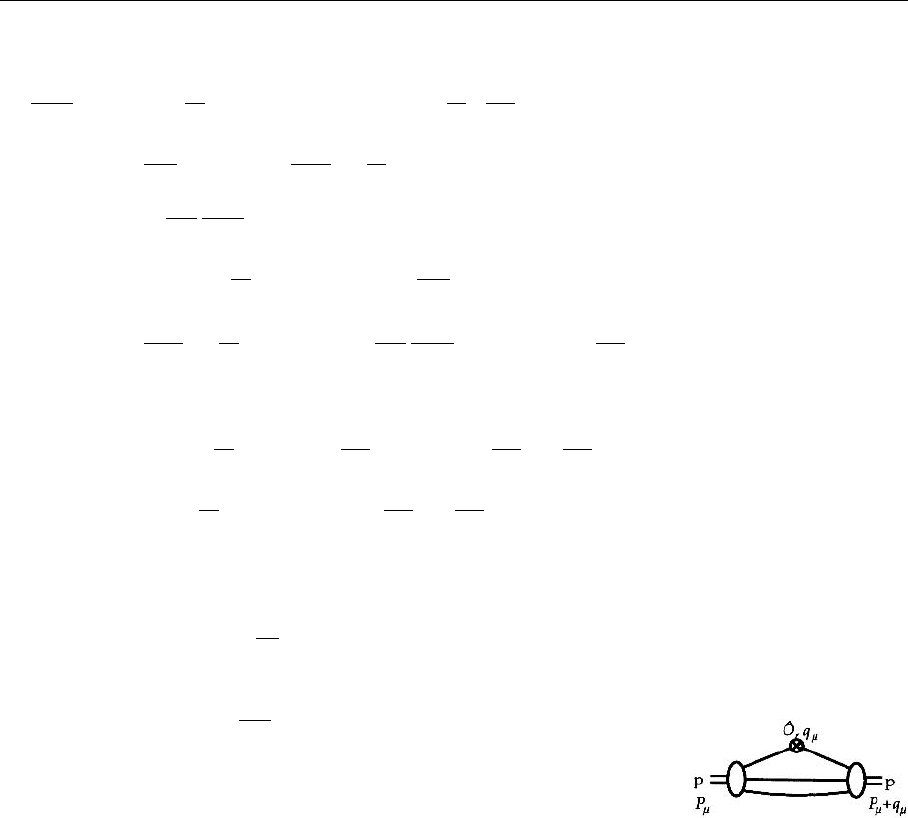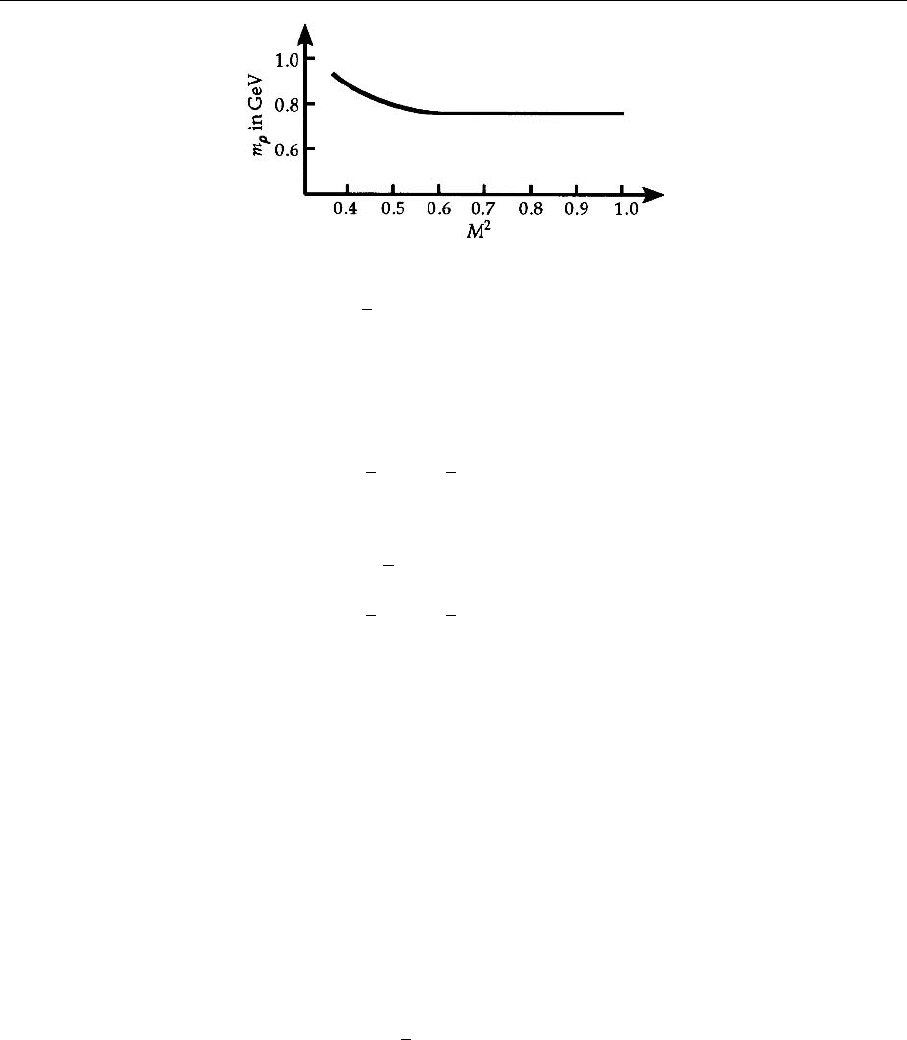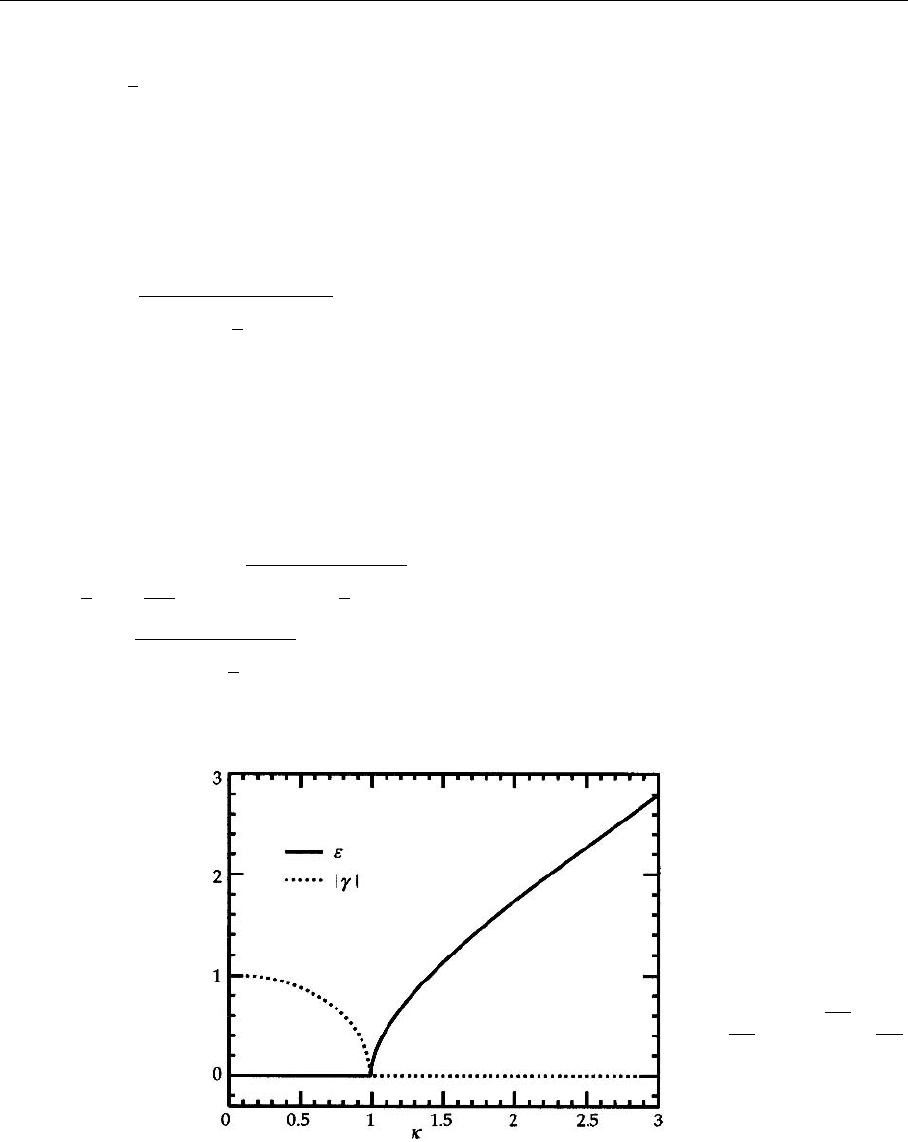Greiner W., Schrammm S., Stein E. Quantum Chromodynamics
Подождите немного. Документ загружается.


510 7. Nonperturbative QCD
Now the higher twist corrections to the partonic calculations, or the higher-
dimension condensates that parametrize them, are suppressed by powers of Q
2
.
Here Q
2
must be large in order to allow for perturbative calculations in α. Thus
making M
2
small would require very large values of n. But such high derivatives
increase the importance of the higher twist effects as
Q
2n
(n −1)!
−
d
dQ
2
n
1
Q
2
N
=
(N +n −1)!
(N −1)!
1
(n −1)!
1
Q
2
N
∼
(N +n −1)!
(n −1)!
(7.274)
becomes very large with increasing N. Thus QCD sum rules are for most ap-
plications an expansion with a limited domain of applicability. If M
2
becomes
too small the higher twist effects on the partonic side become uncontrollable;
if it becomes too large, the hadronic side becomes a complicated mixture of
hadronic states. Luckily for most problems one finds an intermediate domain
around M = 1 GeV in which the result depends only slightly on M, indicating
that the approximations made were acceptable. Inserting (7.206), we obtain for
the Borel transform of the hadronic part simply
1
πM
s
0
0
e
−s/M
2
Im Π(s) ds = e
−m
2
/M
2
3πm
2
e
2
f
g
2
R
1
πM
2
. (7.275)
The integral (7.273) is now easy, yielding
1
πM
2
s
0
0
e
−s/M
2
Π
µν
(q
)g
µν
ds
=
1
4π
2
1 +
α
s
π
1 − e
−s
0
/M
2
+
8π
2
M
4
0|m
¯
qq|0
+
π
2
3M
4
-
0
α
s
π
G
a
αβ
G
aαβ
0
.
−
448
81
π
2
α
s
M
6
|0|
¯
qq|0|
2
. (7.276)
This expression can now be equated with (7.275). However, there is still one
last problem to be solved. The current substituted in (7.242) to describe vec-
tor mesons can still be arbitrarily normalized. Thus we introduce a factor λ
and
write
1
4π
2
1 +
α
s
(λ)
π
1 − e
−s
0
/M
2
+
8π
2
M
4
0|m
¯
qq|0
+
π
2
3M
4
-
0
α
s
π
G
a
αβ
G
aαβ
0
.
−
448
81
π
2
α
s
M
6
|0|
¯
qq|0|
2
= λ
1
πM
2
3πm
2
e
2
f
g
2
R
e
−m
2
/M
2
=
1
πM
2
J . (7.277)

7.2 QCD Sum Rules 511
We get rid of λ
and all other constants by dividing dJ/dM
2
by J:
dJ
dM
2
/J =
1 +
α
s
π
1 − e
−s
0
/M
2
−M
2
1 +
α
s
π
s
0
M
2
e
−s
0
/M
2
−
8π
2
M
4
0|m
¯
qq|0−
π
2
3M
4
-
0
α
s
π
G
a
αβ
G
aαβ
0
.
+2 ·
448
81
π
2
α
s
M
6
0|
¯
qq|0
2
×
M
2
1 +
α
s
π
1 − e
−s
0
/M
2
+
8π
2
M
2
0|m
¯
qq|0
+
π
3
3M
2
-
0
α
s
π
G
a
αβ
G
aαβ
0
.
−
448
81
π
2
α
s
M
4
0|
¯
qq|0
2
−1
=
m
2
M
4
,
(7.278)
m
2
= M
2
1 +
α
s
π
1 −
1 +
s
0
M
2
e
−s
0
/M
2
−
1
M
4
A +
2
M
6
B
×
1 +
α
s
π
1 − e
−s
0
/M
2
+
1
M
4
A −
1
M
6
B
−1
. (7.279)
With the condensates from (7.207) the numerical constants are
A =−8π
2
(0.10)
4
GeV
4
+
π
3
3
(0.36)
4
GeV
4
= (−0.007 +0.055) GeV
4
= 0.05 GeV
4
,
B = (0.225)
8
·π
2
·0.25·
448
81
GeV
6
=0.035 GeV
6
. (7.280)
The resulting form of m
2
as a function of M
2
is plotted in Fig. 7.19.
Similar calculations can be repeated for any set of parameters, and the result-
ing masses agree quite well with the real values, except for the pion. However,
the QCD sum-rule technique is not limited to the calculation of masses. It is also
possible to calculate vertices, such as any coupling to the quark in the proton,
according to Fig. 7.18.
The proton current can be written in many different forms. The simplest is
the so-called Ioffe current
η
I
(x) = ε
abc
u
ta
(x)γ
0
γ
2
γ
µ
u
b
(x)
γ
5
γ
µ
d
c
(x). (7.281)
Here, the first u(x) field is transposed so that the bracket is just a number as far as
the spinor indices are concerned and a Lorentz vector with respect to the index
of γ
µ
. It is easy to show that this combination indeed has isospin 1/2 and not 3/2,
which is the second possibility in the coupling of 3 isospin-1/2 objects
Fig. 7.18. The general form
of a proton vertex
ˆ
O at
which momentum q
µ
is
transferred

512 7. Nonperturbative QCD
Fig. 7.19. The rho mass
as a function of M
2
,as
given by (7.227) for s
0
=
1.5GeV
2
. The convergence
is clearly convincing in the
range M
2
=0.5−0.8GeV
2
I
2
= I
2
3
+
1
2
(I
+
I
−
+I
−
I
+
),
I
j
= I
j
(1) + I
j
(2) + I
j
(3), (7.282)
where the I
j
(k) act on quark number k. To show this, one has to use the so-called
Fierz transformation:
I
2
η
I
(x) =
1
4
η
i
(x) +
1
2
I
+
ε
abc
d
ta
(x)γ
0
γ
2
γ
µ
u
b
(x)
γ
5
γ
µ
d
c
(x)
+ε
abc
u
ta
(x)γ
0
γ
2
γ
µ
d
b
(x)
γ
5
γ
µ
d
c
(x)
+
1
2
I
−
ε
abc
u
ta
(x)γ
0
γ
2
γ
µ
u
b
(x)
γ
5
γ
µ
u
c
(x)
=
1
4
η
i
(x) +
3
2
η
i
(x) +ε
abc
d
ta
(x)γ
0
γ
2
γ
µ
u
b
(x)
γ
5
γ
µ
u
c
(x)
+ε
abc
u
ta
(x)γ
0
γ
2
γ
µ
d
b
(x)
γ
5
γ
µ
u
c
(x). (7.283)
The last two terms are equal (please remember that the bracket is just a number).
d
ta
(1)γ
0
γ
2
γ
µ
u
b
(2) =
d
ta
(1)γ
0
γ
2
γ
µ
u
b
(2)
t
= u
bt
(2)γ
t
µ
γ
t
2
γ
t
0
d
a
(1) =−u
bt
(2)γ
2
γ
0
γ
µ
d
a
(1)
= u
bt
(2)γ
0
γ
2
γ
µ
d
a
(1) → u
at
(1)γ
0
γ
2
γ
µ
d
b
(2). (7.284)
In the last step we have used the antisymmetry of ε
abc
and the fact that the to-
tal wave function is odd under the exchange of any two particles. The Fierz
transformation in our case is
γ
5
u
at
γ
0
γ
2
γ
µ
d
b
γ
µ
u
c
=−
1
4
γ
5
u
at
γ
0
γ
2
u
c
d
b
−2
u
at
γ
0
γ
2
γ
µ
u
c
γ
µ
d
b
−2
u
at
γ
0
γ
2
γ
µ
γ
5
u
c
γ
µ
γ
5
d
b
−
u
at
γ
0
γ
2
γ
5
u
c
γ
5
d
b
.
(7.285)

7.2 QCD Sum Rules 513
Now one can see from (7.284) that all combinations for which the transposed
bracket has the opposite sign vanish, owing to the symmetry operation (a → c,
1 → 2). But
u
at
γ
0
γ
2
u
c
t
=u
ct
γ
t
2
γ
t
0
u
a
=−u
ct
γ
0
γ
2
u
a
,
u
at
γ
0
γ
2
γ
µ
γ
5
u
c
t
=u
ct
γ
t
5
γ
0
γ
2
γ
µ
u
a
=−u
ct
γ
0
γ
2
γ
µ
γ
5
u
a
,
u
at
γ
0
γ
2
γ
5
u
c
t
=u
ct
γ
5
γ
2
γ
0
u
a
=−u
ct
γ
0
γ
2
γ
5
u
a
. (7.286)
Thus only the second term in (7.285) survives:
u
at
γ
0
γ
2
γ
µ
d
b
γ
5
γ
µ
u
c
=−
1
2
u
at
(1)γ
0
γ
2
γ
µ
u
c
(3)
γ
µ
γ
5
d
b
(2)
⇒−
1
2
u
at
(1)γ
0
γ
2
γ
µ
u
b
(2)
γ
µ
γ
5
d
c
(3), (7.287)
and we have
I
2
η
I
(x) =
1
4
η
I
(x) +
3
2
η
I
(x) −2 ·
1
2
η
I
(x) =
3
4
η
I
(x) =
1
2
1
2
+1
η
I
(x),
(7.288)
which demonstrates that η
I
(x) indeed has isospin 1/2. In calculating the triangle
graph in Fig. 7.18, basically all techniques are the same except that now we have
to perform a double Borel transformation to make sure that both the incoming
and the outgoing baryons are projected onto the proton state:
s
1
= p
2
, s
2
= ( p +q)
2
,
s
0
0
ds
1
e
−s
1
/2M
2
s
0
0
ds
2
e
−s
2
/2M
2
... . (7.289)
In fact the applicability of QCD sum rules for calculations of quantities other
than masses is not trivial. The Borel transformation projects out the lowest-
mass eigenstate, which is the correct state only if it is unique, i.e., if any state
is uniquely determined by the quantum numbers contained in the current and by
the mass. For fully relativistic problems this is ascertained by general theorems.
With these remarks we wish to end our introduction to QCD sum rules. Let us
summarize what we have done by noting that with the few parameters for the
condensates, one is able to calculate with a typical accuracy of 20%
• the masses of , φ, δ, a
1
, N,Σ,Λ,Ξ,∆,...,
• the vertex constants such as g
πNN
, g
πN∆
, g
ωπ
,...,
• the heavier quarkonia states
1
S
0
,
3
S
1
,
3
P
2
,... for
¯
cc and
¯
bb,
• quantities such as the total momentum carried by quarks or gluons at the scale
M
2
,whichis
q
+
1
0
xq(x) dx,
• the form of the 3-quark component of the nucleon wave function and of
the quark–antiquark component of the pion wave function (the so-called
Chernyak–Zhitnitsky wave functions), and many more quantities.

8. Phenomenological Models
for Nonperturbative QCD Problems
As the complete calculation of many, especially dynamical, nonperturbative
problems, for example, using lattice calculations is still impossible, theoreticants
have tried to develop simple physical models for these problems. Using suit-
able assumptions and parameter choices, one then attempts to reproduce as many
properties of QCD as possible. We shall consider two such problems here: the
ground state of QCD and the quark–gluon plasma. In both cases we shall restrict
ourselves to a few remarks only.
8.1 The Ground State of QCD
Many semiphenomenological models have been developed for the QCD ground
state. We shall consider here only the so-called “Spaghetti vacuum” which is
one of the most promising candidates and has the advantage of being eas-
ily visualized. As a starting point, let us ask what the fate is of a hypothetical
monopole–antimonopole pair in a superconductor. The Meissner–Ochsenfeld
effect teaches us that the flux lines of the magnetic field cannot enter any super-
conducting region. Consequently a region of normal conduction is created in
between the pair (see Fig. 8.1).
Thus a string is created, and, since the energy density in the region of normal
conduction is larger than in the superconductivity region, the magnetic charges
are confined.
Our model system therefore shows the same properties as QCD, with mag-
netic charge and magnetic field playing the role of color charges and color
electric fields. This leads us to the dual superconductor picture, i.e., the assump-
Fig. 8.1. A magnetic mono-
pole–antimonopole (g
g) pair
creates a string of normal
conductance in a supercon-
ductor

516 8. Phenomenological Models for Nonperturbative QCD Problems
tion that the QCD ground state has the properties of a superconductor in which
the roles of magnetic and electric fields are interchanged. To put this on a firm
foundation, one must show that QCD contains some objects that can play the
role of Cooper pairs. As Cooper pairs are bound by electric field, one expects
that their dual partners in QCD are bound by color magnetic fields.
From the many ideas about what these objects might be, we shall discuss only
the “Spaghetti vacuum”, in which the Cooper pairs are strings of color magnetic
fields. To obtain this picture we start with the simplest question and ask how
spontaneous color magnetization can arise in a pure gauge theory. To this end,
we introduce a color magnetic background field H, determine the correspond-
ing vacuum energy, and calculate the total energy with respect to H.Thecolor
electric and color magnetic fields are defined as
E
aj
= F
a
0 j
=∇
0
A
a
j
−∇
j
A
a
0
+gf
abc
A
b
0
A
c
j
, (8.1)
H
aj
=−ε
jik
F
a
ik
=−ε
jik
∇
i
A
a
k
−∇
k
A
a
i
+gf
abc
A
b
i
A
c
k
. (8.2)
To see whether a homogeneous magnetic field can lower the total energy, we set
H
aj
= Hδ
a3
δ
j3
⇒ A
0a
µ
=−Hx
1
δ
µ2
δ
a3
. (8.3)
For simplicity we shall keep to an SU(2) gauge theory. We consider a small
variation A
a
ν
around A
0a
µ
:
F
a
µν
F
aµν
=
∇
µ
A
1
ν
−∇
ν
A
1
µ
+g
A
2
µ
A
3
ν
−Hx
1
δ
ν2
−
A
3
µ
−Hx
1
δ
µ2
A
2
ν
2
+
∇
µ
A
2
ν
−∇
ν
A
2
µ
+g
A
3
µ
−Hx
1
δ
µ2
A
1
ν
− A
1
µ
A
3
ν
−Hx
1
δ
ν2
2
+2H
2
+
∇
µ
A
3
ν
−∇
ν
A
3
µ
+g
A
1
µ
A
2
ν
− A
2
µ
A
1
ν
2
+2
∇
µ
A
3
ν
−∇
ν
A
3
µ
+g
A
1
µ
A
2
ν
− A
2
µ
A
1
ν
×
(
−H
)
δ
µ1
δ
ν2
−δ
µ2
δ
ν1
. (8.4)
We consider small variations around H
aµ
and therefore neglect higher powers
in A:
F
a
µν
F
aµν
≈
∇
µ
A
1
ν
−∇
ν
A
1
µ
−gHx
1
A
2
µ
δ
ν2
− A
2
ν
δ
µ2
2
+
∇
µ
A
2
ν
−∇
ν
A
2
µ
−gHx
1
A
1
ν
δ
µ2
− A
1
µ
δ
ν1
2
+2H
2
+
∇
µ
A
3
ν
−∇
ν
A
3
µ
2
−4H
∇
1
A
3
2
−∇
2
A
3
1
+g
A
1
1
A
2
2
− A
2
1
A
1
2
. (8.5)

8.1 The Ground State of QCD 517
The source terms for A
3
µ
that appear in the last term vanish by partial integration
of the action integral if we demand that A
3
2
(x
1
→±∞) = A
3
1
(x
2
→±∞) = 0.
This is equivalent to demanding a fixed background field. Indeed the appearance
of this source term is an indication that A
3
µ
is not a physical degree of freedom,
and it can be shown that A
1
µ
and A
2
µ
are the only physical degrees of freedom.
We shall content ourselves here with the observation that the source terms vanish
by partial integration and that the only remaining term in A
3
µ
is a free Lagrange
density and is therefore not of interest to us. Dropping these terms we have
F
a
µν
F
a µν
=
∇
µ
A
1
ν
+i A
2
ν
−∇
ν
A
1
µ
+i A
2
µ
−gHx
1
A
2
µ
−i A
1
µ
δ
ν2
−
A
2
ν
−i A
1
ν
δ
µ2
2
+2H
2
−i2gH
A
1
1
+i A
2
1
A
1
2
−i A
2
2
−
A
1
2
+i A
2
2
A
1
1
−i A
2
1
. (8.6)
In the last step, we have rewritten F
a
µν
F
aµν
in a way to show that it is useful to
replace A
1
µ
and A
2
µ
by
W
µ
=
1
√
2
A
1
µ
+i A
2
µ
, W
+
µ
=
1
√
2
A
1
µ
−i A
2
µ
. (8.7)
With these we obtain
F
a
µν
F
aµν
=2
∇
µ
−igHx
1
δ
µ2
W
ν
−
(
∇
ν
−igHx
1
δ
ν2
)
W
µ
2
+4igH
W
+
1
W
2
−W
+
2
W
1
+2H
2
. (8.8)
The Lagrange density to be investigated is thus
L =−
1
4
F
a
µν
F
aµν
=−
1
2
∇
µ
−igHx
1
δ
µ2
W
ν
−
(
∇
ν
−igHx
1
δ
ν2
)
W
µ
2
−igH
W
+
1
W
2
−W
+
2
W
1
−
1
2
H
2
, (8.9)
and the resulting equation of motion is
−
−∇
µ
−igHx
1
δ
µ2
∇
µ
−igHx
1
δ
µ2
W
ν
−
(
∇
ν
−igHx
1
δ
ν2
)
W
µ
−igH
(
δ
ν1
W
2
−δ
ν2
W
1
)
= 0 . (8.10)
To make sure that W
+
µ
, W
µ
are indeed the physical degrees of freedom, it is
useful to choose the so-called background gauge:
∂
µ
−igHx
1
δ
µ2
W
µ
=0 . (8.11)
(For H →0, this is the usual transverse gauge.)
That this gauge singles out the physical degrees of freedom is formally
demonstrated by choosing the gauge (8.11), determining the corresponding
ghost fields, and then showing that they cancel the contribution of A
3
µ
and those
components of W
µ
for which
∂
µ
−igHx
1
δ
µ2
W
µ
= 0.

518 8. Phenomenological Models for Nonperturbative QCD Problems
From (8.11) it follows that
∇
µ
+igHx
1
δ
µ2
∇
µ
−igHx
1
δ
µ2
W
ν
=
∇
µ
−igHx
1
δ
µ2
∇
µ
−igHx
1
δ
µ2
W
ν
=
(
∇
ν
−igHx
1
δ
ν2
)
∇
µ
+igHx
1
δ
µ2
W
µ
−igH(−δ
µ1
)δ
ν2
W
µ
−igHδ
ν1
δ
µ2
W
µ
=−igH(W
2
δ
ν1
−W
1
δ
ν2
), (8.12)
or
∇
µ
−igHx
1
δ
µ2
2
W
ν
−2gH
⎛
⎜
⎝
0000
00i0
0 −i00
0000
⎞
⎟
⎠
νµ
W
µ
= 0 . (8.13)
The matrix in (8.13) has the eigenvalues ±1 and a double eigenvalue at zero. Its
eigenvectors are (0, 1, ∓i, 0), (0, 0, 0, 1), (1, 0, 0, 0). The last is excluded by the
gauge condition (8.11), while the others correspond to spin ±1 and 0. The matrix
in (8.13) contains the submatrix
(S
3
)
jk
=iε
3 jk
=
⎛
⎝
0i0
−i00
000
⎞
⎠
, (8.14)
i.e., the third component of the spin matrix for spin 1. The factor 2 is analogous
to the g factor. Since gluons are massless, S = 0 is excluded (formally one finds
that ghost fields cancel the contribution of S = 0 gluons). Thus the two physical
fields are those with S =±1, and they satisfy
∇
µ
−igHx
1
δ
µ2
2
W
ν
−2gH ·(±1)W
ν
=
)
−
∂
2
∂x
2
0
+
∂
2
∂x
2
1
−
i
∂
∂x
2
+gHx
1
2
+
∂
2
∂x
2
3
±2gH
*
W
ν
=0 . (8.15)
Continuing to the Fourier transform
˜
W
ν
(E, x
1
, k
2
, k
3
) we have
E
2
+
∂
2
∂x
2
1
−(k
2
+gHx
1
)
2
−k
2
3
∓2gH
˜
W
ν
=0 , (8.16)
and we substitute x
1
= y −k
2
/gH:
E
2
−k
2
3
∓2gH +
∂
2
∂y
2
−g
2
H
2
y
2
˜
W
ν
(E, y, k
2
, k
3
) = 0 . (8.17)
The last two terms correspond to the equation of the harmonic oscillator:
ωΨ( y) =−
1
2
∂
2
∂y
2
−
1
2
g
2
H
2
y
2
Ψ( y) (8.18)

8.1 The Ground State of QCD 519
with energy eigenvalues
ω
n
=
n +
1
2
gH . (8.19)
With the ansatz
˜
W
ν
=Ψ( y)φ(E, k
2
, k
3
) (8.20)
it now follows that
E
2
−k
2
3
∓2gH −2ω
n
˜
W
ν
= 0 (8.21)
⇒ E =
6
2gH
n +
1
2
±1
+k
2
3
= E
+iΓ. (8.22)
Note that E becomes imaginary for n = 0andk
2
3
< gH. Since an imaginary
energy corresponds to a decay width, this state is unstable (see Fig. 8.2).
The appearance of an unstable mode indicates that the model assumptions
of a homogeneous color magnetic field are unrealistic. In spite of this, we shall
investigate what result would be obtained if this state were not unstable, since
this will help us to understand the role of the unstable mode.
From the single-particle energies (8.22) follows the energy density
ε = 2
1
2
C
dk
3
2π
∞
n=0
6
2gH
n −
1
2
+k
2
3
+
∞
n=0
6
2gH
n +
3
2
+k
2
3
. (8.23)
Fig. 8.2. The unstable mode,
with ε = E
1
/
√
gH, γ =
Γ/
√
gH,andκ =k
3
/
√
gH.
For κ<1 the energy is
zero and the state decays
or grows exponentially de-
pending on the sign of γ

520 8. Phenomenological Models for Nonperturbative QCD Problems
The factor 2 stands for the two degrees of freedom W
µ
and W
+
µ
; the factor 1/2
appears because we are calculating the vacuum energy. The factor C comes from
changing
+
dk
1
dk
2
to
∞
n=0
.Sinceforthenth Landau state it holds that
k
2
1
+k
2
2
∼ngH , (8.24)
we expect that
+
dk
1
dk
2
(2π)
2
⇒
+
k dk
2π
⇒
gH
4π
n
. (8.25)
A precise calculation yields
C =
gH
2π
, (8.26)
ε −ε(H = 0) =
gH
2π
dk
3
2π
'
∞
n=1
6
2gH
n −
1
2
+k
2
3
+
∞
n=0
6
2gH
n +
3
2
+k
2
3
(
−2 ×2 ×
1
2
d
3
k
(2π)
3
"
k
2
+
gH
2π
dk
3
2π
k
2
3
−gH . (8.27)
The factors in front of the last-but-one term are spin degrees of freedom × color
degrees of freedom ×
1
2
. To perform the sums we introduce parameters δ and η:
ε −ε(H = 0) = lim
η,δ→0
⎡
⎣
gH
π
∞
0
dk
3
2π
#
∞
n=1
2gH
n −
1
2
+k
2
3
−iδ
1/2+η
+
2gH
n +
3
2
+k
2
3
−iδ
1/2−η
&
−
1
π
2
∞
0
dkk
2
k
2
−iδ
1/2−η
+
gH
2π
2
∞
0
dk
3
(k
2
3
−gH −iδ)
1/2−η
⎤
⎦
(8.28)
